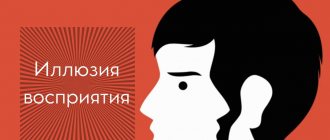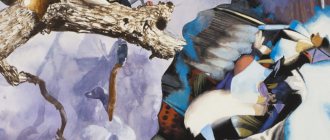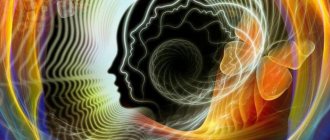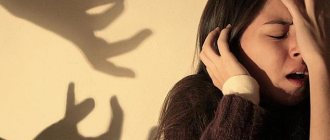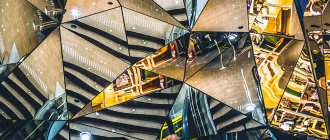Illusion of perception in psychology.
Mirages, distorted sounds and images are all illusions of perception. They arise against the background of the fact that a person distorts the interpretation of stimuli perceived through the senses. The impressions he receives at the same time force him to draw incorrect conclusions about the properties of the stimulus object. The visible, audible, and tangible in a distorted form differs from the real stimulus. The discrepancy can be eliminated through measurement and analysis.
Concept and essence
Illusion is a distorted perception of reality, which is based on deception of the senses. A person begins to perceive the imaginary as the real. The term “distorted” means that the object that an individual sees does not correspond to the surrounding reality. Distortion can be easily eliminated by understanding the reasons for its occurrence or by taking a series of measurements. Sometimes illusions are associated with what a person does not believe in.
Types of distortion:
- Illusions that are associated with water, the influence of a prism, are mirages, distortions of air due to hot steam. Based on physical phenomena.
- Illusions associated with the peculiarities of perception. Distortions are based on psychology and physiology.
The most studied are visual illusions. On the Internet or special textbooks you can find images that appear to move, but at the same time remain in place.
Cognitive illusions
Such phenomena arise due to the fact that a person begins to make assumptions about the world, which leads to analysis, sometimes unconscious. Cognitive illusions are erroneous thinking; they develop as a result of mental behavior. Such an illusion of a person is an example of fast thinking; if a person had initially analyzed his thoughts, it would not have arisen. Cognitive distortions are actively studied in psychotherapy because they carry personal and social consequences.
History of discovery
The perception of reality began to receive attention in 1899. Illusions were familiar to people before, but were perceived as something mystical and frightening.
The first researchers in this direction conducted experiments to prove that illusions are based on people's expectations. These experiments involved lifting weights while blind. The buckets contained the same amount of sand, but people were told that they would now be allowed to lift the bucket even heavier. Participants in the experiment believed that buckets of equal weight were heavier than each other.
The first scientist to conduct such experiments was R. Muller. He asked people to estimate the same weight in containers of different sizes.
After conducting the experiments, Müller presented his personal arguments regarding similar distortions in the Würzburg school. Scientists from other European psychological schools began to develop and study this concept in the first half of the 20th century. They called illusions the anomalous phenomena that occur in nature - mirages, visual distortions due to the refraction of light. Psychologists from the Gestalt school shared this opinion.
Diagnostics
To assess the quality of illusory perceptions, a test was invented in Denmark that involved working with a figure (a white vase) and 2 black dots. “Rubin’s Vase” allows you to interpret the results as the ability to see 2 objects when observing contrasting images falling on the retina. A visual test can be done using pictures like these.
The point of the study is to evaluate the dual nature of perception. In 1930, E. Boring determined the actual content of objects and their ability to interact with humans.
As a result, the conclusion was reached: Gestalt psychologists who combine forms with structures are right - a person can see 2 objects when viewing a single image. In this case, the ability to “switch” between subjects of perception within the human psyche is assessed.
Ponzo illusion - working with the perspective of images. Against the background of the railway tracks stretching into the distance, 2 objects far and near seem different, although in meaning they are conceived in a single expression of form. The human brain perceives a distant object as large in size because it is distant in perspective. When you get closer, it will appear even larger than what is shown up close. Although in fact small details are drawn in the distance, and a large object is drawn near. This testing explains the theory of Helmholtz, who described the illusion of information perception.
Causes
Causes:
- Taking medications, alcohol, or drugs that distort the perception of reality.
- Natural physical processes in nature - mirages, rainbows, refraction of light through drops of water.
- A distortion imposed by the opinions of other people.
- Mental disorders, diseases.
- Physical pathologies. For example, in extreme heat, an individual may become delirious and see imaginary objects.
- Strong experiences, stress, nervous breakdowns, depression.
An interesting cause of illusions is synesthesia. This is a process of mixing feelings. Synesthesia is very common among creative people:
- Many musicians report that they can see special colors when playing melodies.
- Poets say that when looking at different images they hear sounds that are not really there.
Penrose triangle
It was discovered back in 1935 by the Swedish artist Oscar Reutersvard, who depicted it in the form of a set of cubes. But he gained fame after the publication of an article by Roger Penrose in 1958 about impossible figures, where he was depicted as three beams connected together.
The impossible triangle is possible! His sculpture is in the German Technical Museum and in the city of Perth in Australia.
Penrose Triangle in Perth, Australia
Penrose triangle at the German Technical Museum
Penrose triangle at the German Technical Museum
Kinds
There are different types of illusions. Each type differs in the affected areas of perception, sensations, and general impact on the psyche.
Physical
The most obvious physical illusions are optical distortions. They are caused by various manifestations of the psyche, which are squeezed between a person and the object, object or phenomenon perceived by him. Examples:
- The moon high in the sky appears much smaller than at the horizon.
- If you submerge a straight stick halfway in water, the submerged end will appear smaller.
- After looking at something bright for a long time, an imprint of this object will remain in front of your eyes for a few seconds, but in reality it will not be there.
- It seems that the mountains are closer in clear weather with low air humidity than they actually are.
Cognitive
Cognitive distortions occur when an individual interacts not with the world itself, but with assumptions about it. This leads to the formation of unconscious conclusions that distort reality. Kinds:
- Ambiguous - Necker Cube, Rubin Vase.
- Distorting - geometric optical illusions. They are characterized by distortion of length, size, curvature, and location of geometric objects.
- Paradox distortions - appearing to be objects that are impossible or paradoxical.
A separate type of cognitive illusions is fiction.
Physiological
They arise under the influence of fatigue, tension, and emotional outbursts. Distortions of a physical and physiological nature are temporary. They disappear on their own after a certain period of time.
Physiological deviations are created against the background of discrepancies between real objects and erroneous phenomena. This group includes the false perception of visually reduced sizes of a large object.
Affective
They appear in healthy people physically and psychologically. They are associated with fatigue, mental stress, and strong emotions. Affective illusions appear in places unfamiliar to a person, when he expects bad things.
If a person is on the territory of an unfamiliar private house, and was frightened by a dog as a child, he will expect an attack by the animal. He can hear sounds that don't exist.
Pathological
Associated with mental disorders and psychological diseases. In this state, it is difficult for a person to distinguish reality from an imaginary illusion. The distortions go away on their own, but without proper treatment they return.
Verbal
Distorted perception of sound stimuli. The neutral speech of another person is perceived as a threat, and hostile reproaches, curses, and insults do not reach the person. If a radio or television is on, a person may feel that the announcers are talking to him.
Organic
They manifest themselves as distorted visual perception of objects, phenomena, and forms. The shape, size, color, and location in space are perceived incorrectly.
Awareness
They manifest themselves as an obsessive feeling that someone is present nearby. If treatment is not started, hallucinations and delusions will develop.
Perceptions
False perception of reality. When they manifest themselves, a person experiences sensory impressions that go against reality. Illusions can incline a person to incorrect judgments and opinions.
Pareidolic
The perception of patterns changes. When considering them, complex images develop in the human mind, which are arranged into fantastic pictures.
What is an illusion?
A similar phenomenon can be created by a skilled magician or mother nature herself, but it happens that a person deceives himself. An illusion is when a real object or phenomenon is perceived in a distorted form and is understood ambiguously. It is believed that illusion is a companion to any mental illness, but this is not entirely true; a healthy person is also capable of experiencing illusion. How can you see an illusion?
- Due to optical illusion.
- Being in a state that is unusual for a person (drug intoxication, pathology or emotional state).
In everyday terms, illusion refers to hopes and dreams. The unreal world that illusion creates is a world of self-deception, and serves as a means that makes life easier for a person or is even a flight of his imagination. Human consciousness always strives to protect itself from shocks and strive for illusion, encourages dreams of a miracle, creates images of a “beautiful life” or ideal people.
How to stop living in a fictional world?
Often people live in a fictional world and do not realize it. Sometimes a person imposes distortions on himself in order to isolate himself from the dangers of the world around him, to close himself off from others. Such actions can lead to the development of mental disorders and psychological diseases. To correct the situation, you need:
- Learn to live according to a schedule. Make it up for every day. Make time for rest, work, hobbies, communication with friends and family. Maintain order in everything. This applies to the schedule, diet, order on the table, in the closets.
- Analyze experienced situations daily and think through ways to solve problems.
- Change your social circle, your field of activity. If you don’t want to lose your job, you need to ask for a vacation to rest.
You also need to pay attention to internal fears, false beliefs, and barriers. To cope with them, you need to consult a psychologist.
In psychology, there are different interpretations of the term “illusion”. Each of them is tolerant of the other. Illusion is a distortion of reality under the influence of external factors. They can be harmless or intrusive. In the latter case, you will need the help of an experienced psychologist.
Impossible trident
The Impossible Trident is the most famous of the impossible figures. Three round teeth gradually turn into two rectangular ones. Although, if you horizontally divide the trident into 2 parts, then both of them will be quite understandable objects. On top there are two rectangular teeth, on the bottom there are three round ones.
The “impossibility” of the trident is achieved thanks to:
- changing foreground and background
- the transition of flat edges at the top of the trident to three-dimensional (round) ones at the bottom
The Impossible Trident appeared almost simultaneously in various publications in the mid-60s of the last century. Norman Mingo's most famous illustration was featured on the cover of MAD magazine in March 1965.
Examples
A person creates many illusions in life.
The following illusions can be considered examples of such constructions:
- all people are kind, cats are affectionate, and dogs are evil;
- all parents love their children;
- homemade food is the healthiest and most delicious;
- it is impossible to drown in the sea because the water is salty and keeps the body on the surface;
- every person is born for great things;
- Every citizen can become a successful politician;
- the state takes care of all its citizens;
- Only in an educational institution can one obtain the knowledge and necessary skills.
How taste buds deceive us
Research shows that our sense of taste is also not the most reliable source of information.
So, wine connoisseurs were given The Red and the White to try the same drink. In the first case, it was a regular white wine, and people indicated its characteristic notes. Red food coloring was then added to the same drink and given to the participants again. This time, connoisseurs felt notes characteristic of red wine, although the drink was the same.
Even the color of the dishes can affect the taste of food. The study demonstrated Cup color influences the taste of hot chocolate that when hot chocolate was served in a cream or orange cup, participants perceived it as sweeter and more flavorful than when served in a white or red cup.
This works with any drink: yellow cans enhance the lemon flavor, blue soda is a better thirst quencher than red soda, and pink soda tastes sweeter.
If the sense of taste is so easily deceived, one might assume that tactile perception cannot be trusted either. And indeed it is.
Escher. Gazebo
In the painting “Belvedere” by Maurits Karnelis Escher, a young man sitting on a bench holds in his hands an absurd resemblance to a cube. He thoughtfully examines this incomprehensible object, while an equally incomprehensible belvedere is built behind him. On the floor of the lower landing there is a ladder that two people climb. However, upon reaching the top platform, they will again find themselves outside, under the open sky. But no one cares about the prisoner who sticks his head between the bars of the prison bars and bemoans his fate.

